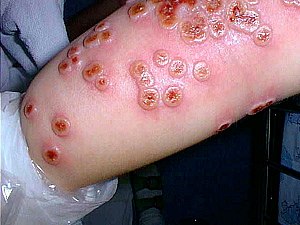Cow-pox
| Cowpox | |
|---|---|
 |
|
| Cowpox lesions on patient’s forearm on day 7 after onset of illness. The hemagglutinin gene of the isolate clustered with a Russian cowpox virus strain, and more distantly, with other cowpox and vaccinia virus strains. The patient’s dog had orthopoxvirus-specific antibodies, indicating a possible transmission route. | |
| Classification and external resources | |
| Specialty | infectious disease |
| ICD-10 | B08.0 |
| ICD-9-CM | 051.01 |
| MeSH | D015605 |
| Cowpox virus | |
|---|---|
 |
|
| Cowpox virus | |
| Virus classification | |
| Group: | Group I (dsDNA) |
| Order: | Unassigned |
| Family: | Poxviridae |
| Subfamily: | Chordopoxvirinae |
| Genus: | Orthopoxvirus |
| Type species | |
|
Vaccinia virus |
|
| Species | |
|
Cowpox virus |
|
Cowpox virus
Cowpox is an infectious disease caused by the cowpox virus. The virus, part of the orthopoxvirus family, is closely related to the vaccinia virus. The virus is zoonotic, meaning that it is transferable between species, such as from animal to human. The transferral of the disease was first observed in dairymaids who touched the udders of infected cows and consequently developed the signature pustules on their hands. Cowpox is more commonly found in animals other than bovines, such as rodents. Cowpox is similar to, but much milder than, the highly contagious and often deadly smallpox disease. Its close resemblance to the mild form of smallpox and the observation that dairymaids were immune from smallpox inspired the first smallpox vaccine, created and administered by English physician Edward Jenner.
The word “vaccination,” coined by Jenner in 1796, is derived from the Latin root vaccinus, meaning of or from the cow. Once vaccinated, a patient develops antibodies that make them immune to cowpox, but they also develop immunity to the smallpox virus, or Variola virus. The cowpox vaccinations and later incarnations proved so successful that in 1980, the World Health Organization announced that smallpox was the first disease to be eradicated by vaccination efforts worldwide. Other orthopox viruses remain prevalent in certain communities and continue to infect humans, such as the cowpox virus (CPXV) in Europe, vaccinia in Brazil, and monkeypox virus in Central and West Africa.
Naturally occurring cases of cowpox were not common, but it was discovered that the vaccine could be “carried” in humans and reproduced and disseminated human-to-human. Jenner’s original vaccination used lymph from the cowpox pustule on a milkmaid, and subsequent “arm-to-arm” vaccinations applied the same principle. As this transfer of human fluids came with its own set of complications, a safer manner of producing the vaccine was first introduced in Italy, The new method used cows to manufacture the vaccine using a process called “retrovaccination,” in which a heifer was inoculated with humanized cowpox virus, and it was passed from calf to calf to produce massive quantities efficiently and safely. This then led to the next incarnation, “true animal vaccine,” which used the same process but began with naturally-occurring cowpox virus, and not the humanized form.
...
Wikipedia
